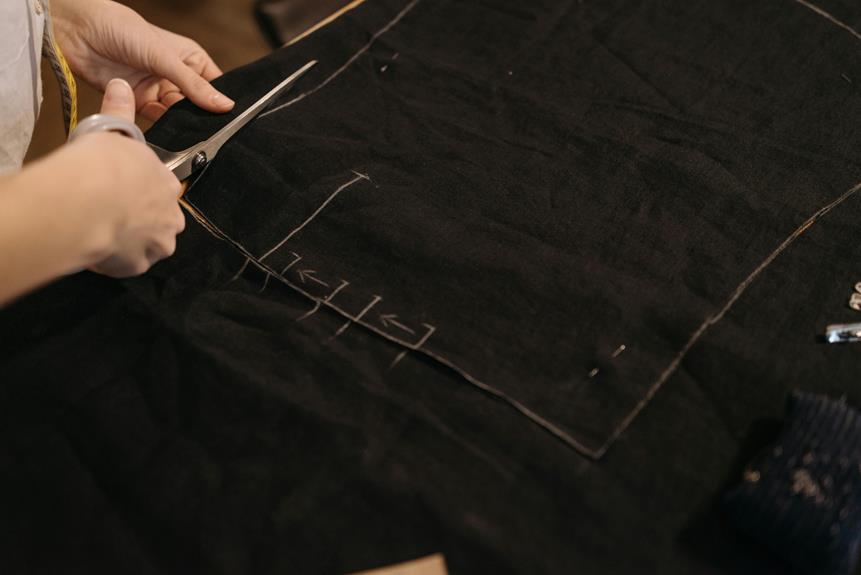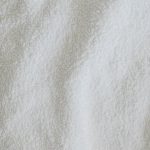When you're faced with selecting a cutting method for fabrics, it's crucial to start by understanding the specific type of material you're working with. Different fabrics have unique properties that can influence your choice of tools and techniques. For instance, woven fabrics often require a different approach than knits. By considering factors like fabric type, project size, and desired finish, you can streamline the process and achieve cleaner edges. But what happens if you choose the wrong method? The implications might surprise you.
Table of Contents
Key Takeaways
- Identify the fabric type (woven, knit, or non-woven) to select the appropriate cutting method and tools for clean cuts.
- Use fabric scissors for lightweight materials and rotary cutters for thicker fabrics to enhance cutting accuracy.
- Consider project complexity; intricate designs require precise cutting techniques like laser cutting or sharp scissors.
- Assess budget constraints; manual tools are cost-effective for small projects while automated machines suit large-scale production.
Understanding Fabric Types
To choose the right cutting method, you first need to understand the different types of fabrics and how their unique properties affect your approach. Fabrics can be broadly categorized into woven, knit, and non-woven types, each presenting distinct challenges and requirements for cutting.
Woven fabrics, like cotton and silk, consist of interlaced threads, making them stable but prone to fraying. You'll need to use a cutting method that minimizes this issue, such as using a rotary cutter or sharp scissors.
Knit fabrics, such as jersey and spandex, stretch, which means you should opt for a method that accommodates that elasticity. Avoid tugging on the fabric as you cut to prevent distortions.
Non-woven fabrics, like felt, are made from fibers that are bonded together, which makes them less likely to fray. You can often use scissors or a rotary cutter without worrying too much about edge finishing.
Understanding these fabric types allows you to select an appropriate cutting method that ensures clean edges and maintains the integrity of your material, ultimately leading to better results in your sewing projects.
Overview of Cutting Tools
Selecting the right cutting tool is just as important as understanding the fabric you're working with, as each tool has its own advantages and is suited for specific fabric types.
For instance, fabric scissors are ideal for lightweight materials like cotton and silk, providing precision and control. Their sharp, angled blades allow you to make clean cuts without fraying edges.
If you're working with thicker fabrics, like denim or canvas, rotary cutters are a great choice. They can slice through multiple layers effortlessly, making them perfect for quilting projects. Just remember to use a cutting mat to protect your surfaces.
For intricate designs or detailed work, consider using a craft knife. These tools offer precision for cutting patterns or small shapes, but be careful, as they can be less forgiving on larger pieces.
Comparing Cutting Techniques
When you're choosing a cutting method, it's crucial to compare manual and automated techniques.
Each has its own strengths, especially when it comes to precision and cost-effectiveness.
Understanding these differences will help you make the best choice for your fabric projects.
Manual Vs. Automated Cutting
Many fabric cutters find themselves weighing the benefits of manual versus automated cutting techniques. Each method has its pros and cons, and your choice often depends on your specific needs and resources.
Here's a quick comparison to help you decide:
| Aspect | Manual Cutting | Automated Cutting |
|---|---|---|
| Cost | Generally lower upfront cost | Higher initial investment |
| Flexibility | Great for small batches | Efficient for large volumes |
| Precision | Requires skill & practice | Consistent and precise cuts |
Manual cutting allows for greater flexibility and creativity, especially for unique designs or small projects. You can easily adjust your approach based on the fabric type and pattern. However, it does require more time and skill, which can be a drawback when working on larger projects.
On the other hand, automated cutting machines streamline the process, offering speed and consistency. They're ideal for mass production, but the initial cost can be a barrier. Ultimately, your decision will depend on your production scale, budget, and the level of precision you need.
Precision Cutting Techniques
Precision cutting techniques play a crucial role in achieving accurate and clean edges, ensuring your fabric projects meet the highest quality standards. When it comes to comparing cutting methods, you'll find several effective options to consider.
First up, laser cutting offers unmatched precision. It uses a focused beam to cut through fabric with minimal fraying, perfect for intricate designs.
If you're working with multiple layers, rotary cutting might be your best bet. This technique allows you to cut through several layers simultaneously, speeding up the process without sacrificing accuracy.
For those who favor manual methods, the use of sharp fabric scissors can still deliver great results. Just remember, the quality of your scissors matters; dull blades can lead to uneven edges.
Alternatively, consider using a cutting mat with a straight edge for straight cuts, which helps maintain precision.
Cost-Effectiveness of Methods
Choosing the right cutting technique can significantly impact your budget, as some methods require more investment in tools and materials than others.
When evaluating cost-effectiveness, consider both initial expenses and long-term value. For instance, rotary cutters and mats may have a higher upfront cost, but they offer durability and precision that can save you money on fabric waste in the long run.
On the other hand, traditional scissors are affordable but might lead to uneven cuts, resulting in fabric waste and potentially higher costs for additional materials. Automated cutting machines are another option, but they come with substantial investment. If you're producing large quantities, the efficiency gained can offset their price.
Don't forget to factor in labor costs. Some methods, like manual cutting, might take more time and effort, increasing labor expenses. In contrast, automated solutions can reduce manpower requirements, potentially enhancing your overall efficiency.
Ultimately, weigh the costs against the quality and efficiency each method offers. By doing so, you can choose a cutting technique that aligns with your budget while still delivering the results you need.
Factors Influencing Cutting Method
When choosing a cutting method, you'll want to consider several key factors that can impact your decision.
The type of fabric, the complexity of your project, and your budget all play crucial roles in determining the best approach.
Understanding these elements will help you make informed choices for your fabric cutting needs.
Fabric Type Considerations
The type of fabric you're working with significantly impacts the cutting method you should use. Different fabrics have unique characteristics that can affect how they behave during cutting.
For instance, if you're dealing with lightweight fabrics like chiffon or silk, you'll want a method that minimizes fraying and shifting, such as using a rotary cutter or specialized scissors designed for delicate materials.
On the other hand, heavier fabrics like denim or canvas can withstand more aggressive cutting methods, such as using a straight blade or electric scissors. These tools allow for clean, straight cuts without the risk of damaging the fabric.
Stretch fabrics, like knits or spandex, require a cutting method that accounts for their elasticity. In this case, using a rotary cutter or a pair of sharp fabric scissors can help ensure you get smooth edges without distorting the fabric's shape.
Project Complexity Level
Project complexity directly influences which cutting method you should select, as intricate designs often require more precision and care. When you're tackling a project, consider the complexity level. If you're working on simple patterns, you might get away with basic cutting tools. However, for more detailed designs, you'll need to invest in methods that ensure accuracy.
Here are some key factors to think about when assessing project complexity:
- Design Intricacy: Complex patterns with curves and angles demand higher precision.
- Fabric Thickness: Thicker materials may require specialized cutting techniques to avoid fraying or deforming.
- Layering: If you're cutting multiple layers, the method must be capable of handling them simultaneously without compromising detail.
Budget Constraints Impact
Budget constraints can significantly influence your choice of cutting method, shaping the tools and techniques you'll use for your fabric project. When you're working with a limited budget, it's essential to assess the costs associated with each cutting method to ensure you're making a financially sound decision.
Here's a quick comparison of common cutting methods and their budget implications:
| Cutting Method | Cost Implications |
|---|---|
| Manual Scissors | Low initial cost |
| Rotary Cutters | Moderate investment |
| Laser Cutters | High upfront expense |
| Die Cutting | Variable; depends on dies |
| CNC Machines | Significant investment |
When you're on a budget, opting for manual scissors or rotary cutters can save you money while still providing accurate cuts. If you can, consider investing in a rotary cutter, as it offers better efficiency without breaking the bank. On the other hand, methods like laser cutting or CNC machines may not be feasible unless you're working on a larger scale project where the initial investment pays off over time. Always align your cutting method with your budget to ensure a successful project.
Tips for Clean Edges
To achieve clean edges when cutting fabrics, always use sharp scissors or a rotary cutter for precise lines. Dull blades can cause fraying and uneven cuts, so make sure to keep your tools in top condition.
Here are some tips to help you achieve those clean edges:
- Cut on a flat surface: Ensure your fabric is laid out on a stable, flat surface to avoid any shifting while cutting.
- Pin or weigh down your fabric: Use pins or weights to keep your fabric in place, preventing it from moving as you cut.
- Use a cutting mat: A self-healing cutting mat not only protects your surfaces but also provides a better grip for your fabric, reducing slipping.
Safety Considerations
When cutting fabrics, it's essential to prioritize safety by always keeping your tools away from your body and ensuring your workspace is free from distractions. Sharp scissors and rotary cutters can cause serious injuries if not handled properly, so always use them with caution.
Make sure your cutting surface is stable and level to prevent slips that could lead to accidents. Wear safety goggles if you're using power tools or cutting materials that could generate debris. Keep your fingers clear of the cutting path, and never rush the process.
If you're working with a rotary cutter, use a cutting mat to protect both your workspace and your tools. It's also wise to store your tools safely. Keep them in a designated container or drawer when not in use, away from children or pets.
If you're feeling tired or distracted, take a break before continuing. Fatigue can lead to errors that might put you at risk.
Best Practices for Different Fabrics
Understanding the unique properties of different fabrics helps you choose the most effective cutting method for each material. Each fabric has its own characteristics, which can influence how you should approach cutting. Here are some best practices to consider:
Cotton: Use a rotary cutter for clean, straight cuts. Cotton frays easily, so consider using pinking shears or a serger for finished edges.
Silk: Opt for scissors with a sharp blade to avoid snagging. A single layer cutting method is best to maintain precision.
Denim: Because of its thickness, a heavy-duty rotary cutter or fabric shears will work best. Ensure your cutting mat is suitable for such robust materials to avoid damaging your tools.
Knits: Use a ballpoint needle in your rotary cutter to prevent snagging. Cut with the fabric stretched slightly to avoid distortion.
Frequently Asked Questions
What Is the Best Cutting Method for Delicate Fabrics?
When cutting delicate fabrics, you'll want to use sharp scissors or a rotary cutter for precision. Make sure to keep your fabric flat and secure to avoid slipping, which can lead to uneven edges.
Can I Use Regular Scissors for All Fabric Types?
You can use regular scissors for some fabric types, but they might not give clean edges on delicate or thick materials. Consider specialized scissors for better results, especially when working with intricate or challenging fabrics.
How Do I Maintain My Cutting Tools for Longevity?
To maintain your cutting tools for longevity, regularly sharpen them, keep them clean, and store them properly. Avoid cutting materials they're not designed for, and always handle them with care to prevent damage.
Is There a Specific Cutting Technique for Patterned Fabrics?
When cutting patterned fabrics, you should align the pattern carefully and use a rotary cutter for precision. It'll help you avoid misalignment and ensure your design flows seamlessly across the pieces. Always double-check before cutting!
What Are the Common Mistakes to Avoid When Cutting Fabrics?
When cutting fabrics, avoid rushing the process, misaligning patterns, and using dull scissors. Don't forget to double-check measurements and ensure the fabric lies flat. Taking your time helps prevent costly mistakes and ensures precision.
- Tetron Fabric for Marine Applications: Durability and Use Cases - June 18, 2025
- Tetron Fabric for Outdoor Furniture: Weather Resistance and Care - June 18, 2025
- Tetron Fabric for Wall Coverings: Style and Application Tips - June 18, 2025






